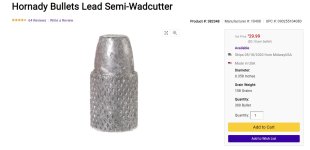I was able to find these LSWC. There is no cannelure. I see the Lyman manual says not to crimp bullets without a cannelure. However, it also says to crimp all revolver cartridges. Conflicted.
You are conflicted only because you don't understand what they mean, yet...
First, the Lyman manual is, in this case, giving you general advice. And good general advice. There are, however, exceptions and "work arounds".
The advice not to crimp where there is no cannelure or crimp groove is sound, and based on the fact that if you try to bend (crimp) the case and it has nowhere to go (no groove) it will squeeze the bullet, and if its a jacketed bullet, resistance to that pressure can buckle the case.
Now, the specific bullets you show are SOFT. Swaged lead bullets are either pure lead or very close to that. IF NECESSARY, you could roll crimp those bullets and all that will happen is you'll crimp the case into the soft lead.
However, it is NOT necessary. If you need a crimp (and, you might) simply seat the bullet so you can roll crimp over the front edge of the full caliber bottom section.
They do distinguish between a roll crimp and a taper crimp. The thing is, these don't have any taper. Should I just lightly crimp them to where I get the correct COL?
The bullets don't "taper", taper and roll refer to the mechanical way the case is bent inwards "crimping" into the bullet. Taper crimp means the case is gradually squeezed against the bullet tapering over a short length. Roll crimp means the case mouth is "rolled" (bent sharply) into the bullet.
next point, "correct length"; correct length for a .38 Special is anything less than 1.550". If you're using .357 brass its anything less than 1.590"
As long as your COL is less than the listed max, it is correct.
The .38 Special is not a "grenade in waiting" like the .40S&W or a hot 9mm load might be. There is plenty of "extra room" in the case so that SMALL changes in the volume of the powder space are not dangerous with regular loads.
Since these are going to be low powered target loads, should I even crimp them at all?
This will depend on the gun you are using. Even with light target loads, recoil in a revolver tries to pull the bullet from the case. The lighter the gun being shot, the greater that pull. Shoot them out of a S&W N frame or a Ruger Redhawk and you might not need any crimp. Shoot them out of a J frame or Detective Special and you will.
The sure way to tell is to shoot some, uncrimped. Load a full cylinder, and shoot, all but one and see if the bullet moved. IF it did, you need some crimp. If you're shooting a really light gun, best check after each shot,

Do you have a fairly current Hornady manual? if not, get one. I just checked one (7th edition 2007) and they do list a COL for that specific bullet. It's 1.455"
Seat a trial round to this COL. See where the full caliber portion of the bullet is, in relation to the case mouth. If its flush, roll crimp lightly and you should be good to go. If not, roll crimp lightly and you should be good to go. Soft bullet, light recoil force, light crimp even if you are crimping where there's no groove, generally works.


